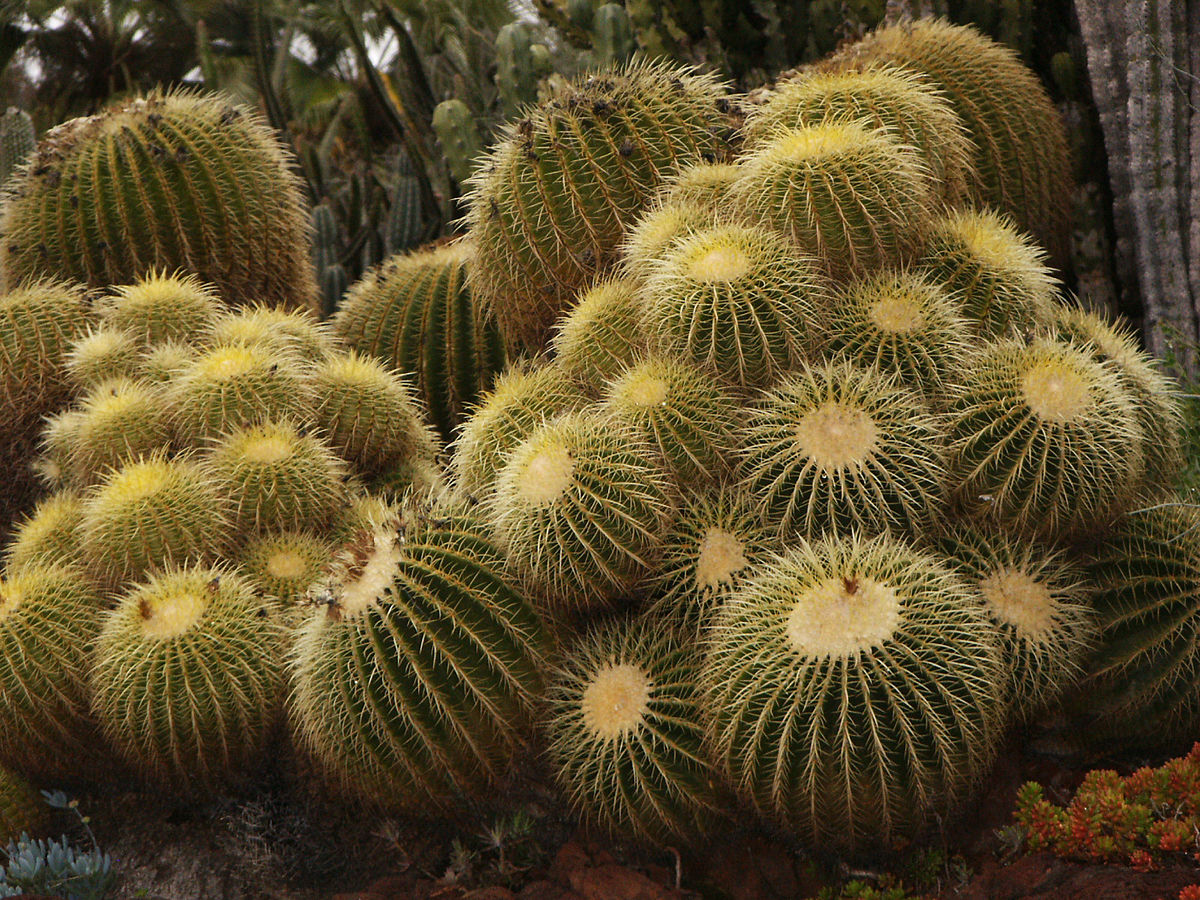Cottontop cactus
(Echinocactus polycephalus xeranthemoides)

Description
Echinocactus polycephalus, commonly known as the "cotton top cactus" or "hedgehog cactus," is a species of cactus native to the Southwestern United States and northern Mexico. It belongs to the family Cactaceae and is well known for its unique and striking appearance. Description Echinocactus polycephalus is a solitary, round cactus with a diameter of up to 24 inches (60 cm). The plant has a shallow root system and grows slowly, usually taking several years to reach maturity. The cactus is covered with numerous sharp spines, which can be up to 2 inches (5 cm) long and are arranged in a spiral pattern around the stem. The stem of the cotton top cactus is green, often with a bluish tinge, and covered with white cotton-like hairs that give the cactus its common name. The cotton-like hairs are actually modified spines and are believed to help protect the plant from extreme temperatures and solar radiation. The cactus produces bright pink or magenta flowers that can grow up to 2 inches (5 cm) in diameter. The flowers are followed by small, round fruit that are covered in spines. Distribution and Habitat Echinocactus polycephalus is native to the Southwestern United States, including Arizona, California, Nevada, New Mexico, and Texas, as well as northern Mexico. The cactus is typically found in desert scrub, grasslands, and rocky slopes, often at elevations of up to 7,000 feet (2,100 m). The plant is well adapted to the hot, dry conditions of the desert, and can survive long periods of drought. It is also able to tolerate cold temperatures, often enduring freezing conditions in winter. However, it is sensitive to prolonged exposure to frost and can be damaged or killed by prolonged exposure to temperatures below 25 degrees Fahrenheit (-4 degrees Celsius). Cultivation and Care Echinocactus polycephalus, also known as the cotton top cactus or hedgehog cactus, is a popular plant among collectors and is often grown in gardens, rock gardens, and containers. The plant is relatively easy to care for and requires minimal maintenance once established. Here are some guidelines for the cultivation and care of Echinocactus polycephalus: Soil: Echinocactus polycephalus prefers well-draining soil. A mixture of sand, gravel, and cactus soil is ideal. The soil should be slightly acidic with a pH range between 6.0 and 7.0. Sunlight: The cactus prefers full sun and should be planted in a location that receives at least six hours of direct sunlight each day. The plant may also benefit from some afternoon shade during the hottest months of the year. Water: Echinocactus polycephalus is sensitive to overwatering and should be watered sparingly. The plant can tolerate drought and prefers to be kept on the dry side. Water only when the soil is completely dry to the touch, usually every two to three weeks during the growing season. In winter, reduce watering frequency to once a month. Fertilizer: Fertilizer is not necessary for Echinocactus polycephalus, but if you want to fertilize, use a balanced cactus fertilizer at half strength once a month during the growing season. Temperature: Echinocactus polycephalus is well adapted to hot, dry conditions, but can also tolerate cold temperatures. The plant can endure freezing conditions in winter but is sensitive to prolonged exposure to frost and can be damaged or killed by prolonged exposure to temperatures below 25 degrees Fahrenheit (-4 degrees Celsius). Repotting: Echinocactus polycephalus has a shallow root system and should be planted in a shallow container. Repot the cactus every two to three years using fresh soil. It is best to repot in the spring before the growing season begins. Pruning: Echinocactus polycephalus does not require pruning, but if you need to remove damaged or dead parts of the plant, use clean, sharp scissors or pruning shears. By following these guidelines, you can cultivate and care for Echinocactus polycephalus successfully. Remember that the plant is slow-growing and may take several years to reach maturity. With proper care, your cotton top cactus can thrive and provide years of enjoyment. Propagation Echinocactus polycephalus can be propagated from seed or by stem cuttings. Here are some guidelines for propagating Echinocactus polycephalus: Propagation from seed: Obtain fresh Echinocactus polycephalus seeds. You can buy them from a reputable nursery or collect them from a mature plant. Fill a shallow container with a well-draining soil mix of sand, gravel, and cactus soil. Water the soil until it is moist but not wet. Scatter the seeds evenly over the surface of the soil. Cover the container with a plastic wrap or lid to create a mini greenhouse effect. Place the container in a warm, bright location that receives indirect sunlight. Keep the soil moist, but not wet. The seeds should germinate within two to four weeks. Propagation by stem cuttings: Choose a healthy, mature Echinocactus polycephalus plant to take the cutting from. Use a clean, sharp knife or pruning shears to make a clean cut on the stem. Make sure the cutting is at least 4 inches (10 cm) long. Let the cutting dry out for a few days to allow it to callus over. Fill a shallow container with a well-draining soil mix of sand, gravel, and cactus soil. Create a hole in the soil and place the cutting in the hole. Water the soil lightly and let it drain. Place the container in a warm, bright location that receives indirect sunlight. Water the cutting sparingly until it has rooted and begins to show signs of new growth. Propagation of Echinocactus polycephalus can be a slow process, so be patient and provide the right growing conditions to ensure success. Once the new plants are established, they can be transplanted into individual pots or planted outdoors in the garden. Uses Echinocactus polycephalus, also known as the cotton top cactus or hedgehog cactus, has a long history of use among Native American tribes. The plant was used for food, medicine, and as a source of water. In addition to its traditional uses, Echinocactus polycephalus is also used in landscaping and as an ornamental plant. Here are some more details about the uses of Echinocactus polycephalus: Food: The pulp of the cactus was traditionally used as a food source by indigenous tribes. They would roast or boil the plant to remove the spines and then eat the flesh. The pulp of the cactus is high in water content and contains some nutrients. Medicine: The pulp of the cactus was also used medicinally. The plant was used to treat wounds, burns, infections, and skin irritations. The sap of the plant was used as a laxative, and the pulp was consumed to help reduce fever and relieve pain. Water source: In desert regions where water is scarce, the pulp of the Echinocactus polycephalus can be a source of water. The pulp can be squeezed to extract the water, which can be consumed. Landscaping: Echinocactus polycephalus is often used in landscaping as a drought-tolerant plant. The plant's unique appearance and low maintenance requirements make it a popular choice for rock gardens, xeriscapes, and container gardens. Ornamental: Echinocactus polycephalus is also grown as an ornamental plant. Its round, spiky appearance and striking pink flowers make it an attractive addition to any garden or indoor space. Overall, Echinocactus polycephalus is a versatile plant with many uses. Its unique appearance, resilience, and adaptability make it an important species for conservation efforts, as well as an intriguing addition to any collection of plants. Conservation Status Echinocactus polycephalus, also known as the cotton top cactus or hedgehog cactus, is listed as a "species of concern" in several states, including California, Nevada, and Arizona. The cactus is also listed as "endangered" under the Mexican Official Standard (NOM-059-SEMARNAT-2010) for the conservation of species at risk. The plant is threatened by habitat destruction, illegal collection, and climate change. Human activities such as urbanization, agriculture, and grazing have led to the loss and fragmentation of Echinocactus polycephalus habitat. The cactus is also threatened by illegal collection, as it is a popular plant among collectors. Climate change is also a concern, as it can lead to changes in temperature and rainfall patterns that can negatively affect the plant's survival. Conservation efforts are underway to protect Echinocactus polycephalus and its habitat. These efforts include habitat restoration, reforestation, and the establishment of protected areas where the cactus can grow and thrive. In addition, laws and regulations have been put in place to limit the collection of Echinocactus polycephalus from the wild. Overall, Echinocactus polycephalus is an important plant species for conservation efforts. Its unique appearance, traditional uses, and ecological value make it an important part of the desert ecosystem. By working to protect and conserve this plant, we can ensure that it continues to thrive for future generations to enjoy. Conclusion Echinocactus polycephalus is a unique and striking cactus with a fascinating history and many uses. The plant's ability to survive in harsh desert conditions and its resilience in the face of environmental challenges make it an important species for conservation efforts. By understanding and appreciating the value of Echinocactus polycephalus, we can work to ensure that this important plant species is protected for future generations to enjoy.
Taxonomic tree:







